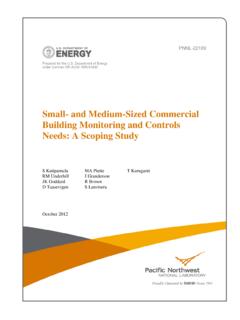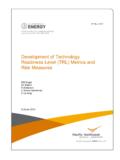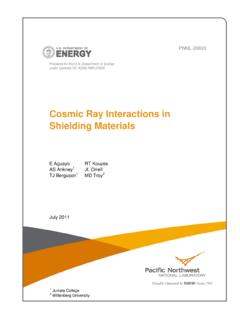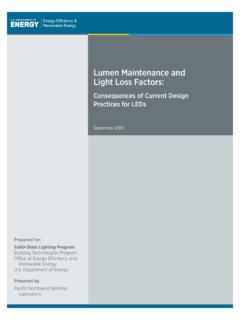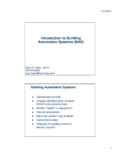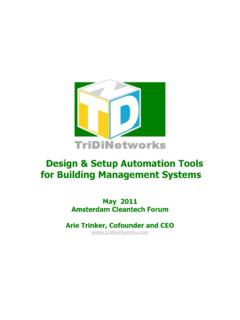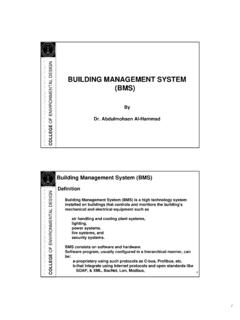Transcription of Energy Management and Control System:Desired …
1 PNNL-15074 Energy Management and Control system : desired Capabilities and Functionality Hatley Meador S. Katipamula Brambley LtCol. Carl Wouden, USAF, Ret. April 2005 Prepared for the Department of Energy under Contract DE-AC05-76RL01830 DISCLAIMER This report was prepared as an account of work sponsored by an agency of the United States Government. Neither the United States Government nor any agency thereof, nor Battelle Memorial Institute, nor any of their employees, makes any warranty, express or implied, or assumes any legal liability or responsibility for the accuracy, completeness, or usefulness of any information, apparatus, product, or process disclosed, or represents that its use would not infringe privately owned rights. Reference herein to any specific commercial product, process, or service by trade name, trademark, manufacturer, or otherwise does not necessarily constitute or imply its endorsement, recommendation, or favoring by the United States Government or any agency thereof, or Battelle Memorial Institute.
2 The views and opinions of authors expressed herein do not necessarily state or reflect those of the United States Government or any agency thereof. PACIFIC NORTHWEST NATIONAL LABORATORY operated by BATTELLE for the UNITED STATES DEPARTMENT OF Energy under Contract DE-AC05-76RL01830 Printed in the United States of America Available to DOE and DOE contractors from the Office of Scientific and Technical Information, Box 62, Oak Ridge, TN 37831-0062; ph: (865) 576-8401 fax: (865) 576-5728 email: Available to the public from the National Technical Information Service, Department of Commerce, 5285 Port Royal Rd., Springfield, VA 22161 ph: (800) 553-6847 fax: (703) 605-6900 email: online ordering: This document was printed on recycled paper. (8/00) Energy Management and Control system : desired Capabilities and Functionality Hatley Meador S.
3 Katipamula Brambley LtCol. Carl Wouden, USAF, Ret. April 2005 Prepared for HQ Air Mobility Command (AMC/CEO) Under a Related Services Agreement with the US Department of Energy Contract DE-AC05-76 RLO 1830 Pacific Northwest National Laboratory Richland, Washington 99352 iii Summary Energy Management and Control system (EMCS) technology has evolved over the past three decades from pneumatic and mechanical devices to direct digital controls (DDC) or computer- based controllers and systems. Today's EMCS systems consist of electronic devices with microprocessors and communication capabilities and utilize widespread use of powerful, low-cost microprocessors and standard cabling communication protocols. This document discusses functions and capabilities of a typical building /facility EMCS. The overall intent is to provide a building operator, manager or engineer with basic background information and recommended functions, capabilities, and good/best practices that will enable the Control systems to be fully utilized/optimized, resulting in improved building occupant quality of life and more reliable, Energy efficient facilities.
4 Most basic functions and some intermediate and advanced functions described in this document are generally required to operate buildings/facilities efficiently. A careful review of the site-specific requirements is recommended before picking the functional requirements of an EMCS. It should be noted that the basic functions described in this document are generally available in most EMCS systems, while the availability of the intermediate and advanced functions vary by manufacturer. iv v Nomenclature AFDD Automated fault detection and diagnostics involves the use of software tools to analyze the behavior of the building , determine if the performance is unsatisfactory (fault detection) and then isolate or localize the fault to facilitate repair (fault diagnosis). The behavior may be observed in the course of an active functional test performed by the tool or in the course of passive monitoring of routine operation.
5 BACnet BACnet is a data communication protocol for building automation and Control networks developed by American Society of Heating, Ventilation, and Air Conditioning Engineers ANSI/ASHRAE 135-1995. A data communication protocol is a set of rules governing the exchange of data over a computer network. BAS building automation systems, also known as EMCS. BMS building Management systems, also known as EMCS. Cascading Resets An example of cascading resets is when both the chilled-water supply temperature as well as the supply air temperature are reset in a sequence. Commissioning A process to ensure that EMCS is designed, installed, functionally tested, and capable of being operated and maintained according to the owner's operational needs. Controller Processes data that is input usually from a sensor, performs logical operations based on the device being controlled and causes an output action to be generated.
6 Economizer Air-side economizers use controllable dampers to increase the amount of outside-air intake into the building when the outside air is cooler than the return air and the building requires cooling. Demand Limiting A Control function that enables Management of peak demand level by shedding predefined loads when the building /facility demand nears a preset maximum. DDC Direct digital controls, also known as EMCS. DDE Direct data exchange is a standard Microsoft Windows message-passing protocol that defines a mechanism for Windows applications to share information with one another. vi Distributed Facility Management of building and facilities that are distributed over a wide Management geographical region. Although each building has its own EMCS systems, the buildings are also managed remotely from a central location through use of gateways and software applications.
7 EMCS Energy Management Control systems FMS Facility Management systems, also known as EMCS. Gateways Devices that allow for integration of Control networks with internet, so that the devices/controllers on the Control network can be accessed through the internet Interoperability Ability of a device/controller or a product to work with other devices/ controllers or products without special effort on the part of the customer. Latent Cooling Moisture removal through dehumidification LonTalk A communication protocol for LonWorks devices to communicate with each other on a LonWorks network. LonWorks A networking platform created by Echelon Corporation. MODBUS A standard communication protocol developed by the Modicon Corporation. The MODBUS protocol is often used in facility metering applications. OLE Object linking and embedding is like DDE, a standard Microsoft Windows message-passing protocol, which defines a mechanism for Windows applications to share information with one another.
8 Ratchet Clause A term in a customer s contract or rate schedule (tariff) that dictates that the customer s billings for each billing period must be based at least in part on the maximum billing received by that customer over a given period, usually the preceding year. Sampling Interval The interval between two consecutive adjustments of Control parameters. Settling Interval Time required for the Control to settle after a change in a Control parameter. Temperature Reset Adjustment of supply temperature higher (during cooling) or lower (during heating) to match the heating and cooling needs. Web-Enabled Device Device that can be directly accessed from a standard internet browser. vii Contents Summary .. iii Nomenclature .. v 1 Functions and Capabilities of Energy Management Control Systems (EMCS) .. 3 Central Information Processing and Control Workstations.
9 4 Day-to-Day Operations ..4 Basic Functions .. 8 Scheduling Function .. 8 Chilled-Water Reset 9 Hot-Water Reset Function .. 9 Supply-Air Temperature Reset Function .. 10 Static Pressure Reset 10 Thermostat 10 Start/Stop Optimization ..11 Economizer Controls ..11 Alarming .. 12 Access to Sensor and Equipment Performance Data .. 13 Intermediate 14 Demand Limiting (Load Shed / Load Rolling).. 14 Duty Cycling .. 16 Event Initiated Controls .. 17 Load Shifting .. 17 Advanced 17 Sequencing and Loading Multiple 17 Load Aggregation .. 18 Automated Fault Detection and Diagnostics .. 18 Monitoring Simultaneous Heating and Cooling .. 19 Tracking Energy -Use ..20 Whole- building Optimization .. 21 Whole-Site Optimization, Integration plus 21 Sensors .. 22 Infrastructure Issues .. 23 Interoperability Issues .. 25 Integration of HVAC Systems with EMCS.
10 27 Cost vs. Benefits .. 29 Commissioning EMCS .. 31 Operator Skills and 33 Control - system 34 viii Figures Figure 1. Schematic of an Example Control Loop .. 3 Tables Table 1 Summary of desired EMCS Functions and 7 1 Introduction Energy Management and Control system (EMCS) technology has evolved over the past 3 decades from pneumatic and mechanical devices to direct digital controls (DDC) or computer based controllers and systems. Today's EMCS systems consist of electronic devices with microprocessors and communication capabilities. Widespread use of powerful, low-cost microprocessors, use of standard cabling, and the adoption of standard communication protocols (such as BACnet, LonWorks, and MODBUS) have led to today's improved EMCS systems. Most modern EMCS systems have powerful microprocessors in the field panels and controllers that will soon be embedded in sensors as well.
